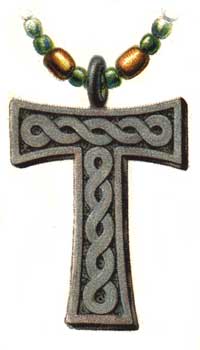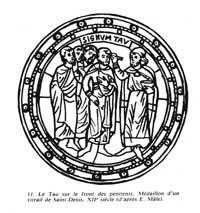Articles
How can we understand the cross, unless we carry a piece of it.
St. Francis
Olivier Messiaen’s opera Saint Francois d'Assise
|
 The Tau Part 1
The Tau Part 1
Continue to Part 2>
Tau: The Anticipatory Cross
The Tau (T) cross is the anticipatory cross, one of the signs from the Old Testament believed by the Early Church Fathers to prefigure Christ.
During the middle ages, the Tau cross became associated with healing and St. Anthony’s fire, and considered the most likely form of cross on which Christ was crucified.
In Hebrew, the taw or tav (ת) letter was represented by a (+) or an (x). (1) As a letter with two lines that cross, the Tau was viewed by early Christians as a letter representing God. This mark was used in baptism and for protection, following the use in Ezekiel 9.
In Greek, the T represented Theos or God. (2) As a mark, a large T appears in some of the inscriptions in the catacombs. (3) However, for most of the first millenium after the crucifixion, either a Greek or Latin cross is used.
Old Testament Signs
Left, a 12th century scene from St. Denis with the mark of the Tau on the foreheads of believers. Right, the brazen serpent from Rudolph Koch,Christian Symbols.
 
Early church fathers found three signs of the tau mark as an anticipatory sign for Christ. (4)
- A mark of the faithful. In Ezekiel 9, the letter taw, the last letter of the Hebrew alphabet, is placed on the forehead of the few who disapprove of wickedness. Those without the mark are sinners and will be slain.
- A mark of protection and salvation. The mark on the door during the Passover, when God passed over the homes of the children of Israel while slaying the Egyptian firstborn, was considered a taw sign.
- A sign of healing. In Numbers 21:6-9, snakes attacked the people of Israel. God told Moses to make a bronze (or copper) serpent and place it on top of a pole. If bitten, those who looked at the pole would be healed.
Continue to Part 2 Next>
Notes
- Jean Danielou, Primitive Christian Symbols, (Baltimore, 1964), trans. Donald Atwater, p.141.[Return]
- George Ferguson, Signs and Symbols in Christian Art, (Oxford University Press, New York, 1961) paperback edition, p. 149.[Return]
- Jack Finegan, The Archeology of the New Testament: The Life of Jesus and the Beginning of the Early Church, (Princeton, 1992) p. 378-79, shows the raised T between the letters e and n in the Irene inscription in the Catacomb of Callistus. Tertullian is quoted in Against Marcion: "Now the Greek letter Tau and our own letter T is the very form of the cross." Damien Vorreux, Un Symbole Franciscain Le Tau (Paris, 1977) shows additional examples, either with the letter inserted within the persons name or to the left or below.[Return]
- Norman Laliberte and Edward N. West, The History of the Cross, (New York, 1960), p. 29. "The typological thinking of the early Fathers was such that they fastened devoutly on any and every Old Testament reference to wood, or to a tree, or a staff, or a rod, or even a stick, seeing in it a prefigure of Christ’s passion."[Return]
|
 The Tau Part 1
The Tau Part 1
